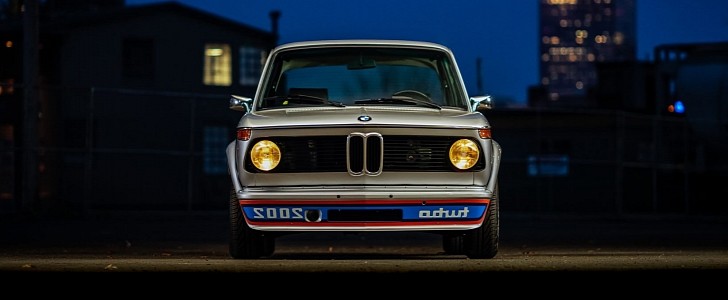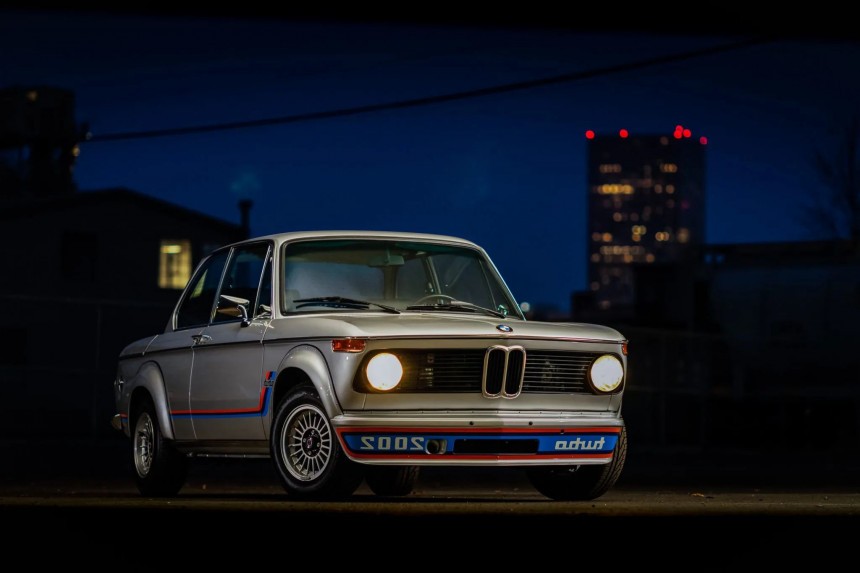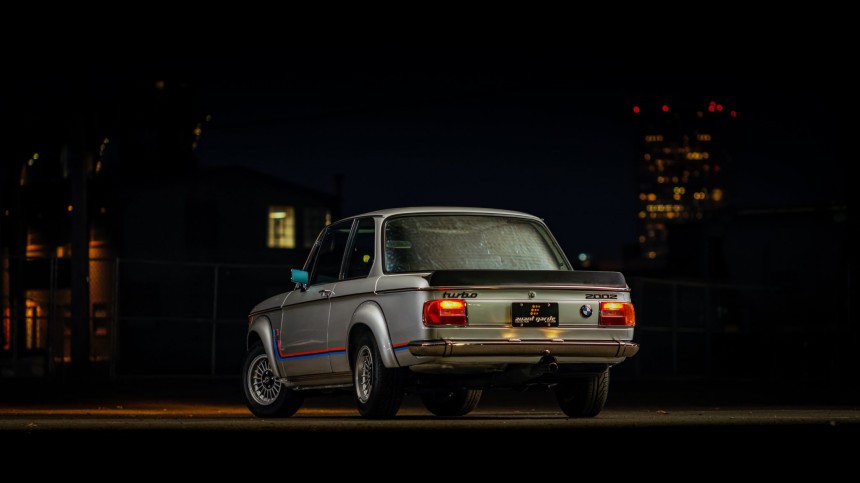All modern BMW M cars and utility vehicles feature turbocharged engines, ranging from the six-cylinder S58 of the second-gen M2 to the eight-cylinder S68 of the polarizing XM. Presented at the 1973 Frankfurt Motor Show, nearly a year after Motorsport GmbH was founded, the iconic 2002 Turbo was the German automaker’s first turbo-equipped production car.
The most performance-oriented member of the 02 Series, the E20 2002 Turbo can thank the E25 Turbo concept for its engine. Developed by a gentleman by the name of Alex von Falkenhausen, the M10 was BMW’s first four-cylinder powerplant since the 309 ended production in 1936. More than 3.5 million units were produced in 26 years of production, and to whom it may concern, the M12/13 racing engine was based on the M10 block.
Reportedly capable of cranking out more than 1,400 metric ponies in qualifying trim, the M12/13 still is the most powerful Formula 1 engine of all time. Then driving for Benetton, Gerhard Berger was clocked at 352 kilometers per hour (219 miles per hour) during the 1986 Italian Grand Prix at Monza, which is pretty impressive for a displacement of just 1.5 liters.
Related to the M15 engine of the 2002 Tii on which the 2002 Turbo is based, the M31 features an 89-millimeter bore and 80-millimeter stroke, which results in a displacement of 2.0 liters. The primary difference between it and the M15 in the 2002 Tii comes in the guise of the KKK BLD turbocharger.
Rated at 170 ps (168 horsepower) and 240 Nm (177 pound-foot) of torque at 7 pounds per square inch of boost, the M31 features a compression ratio of 6.9:1 as opposed to 9.5:1 for the naturally-aspirated M15. Rather than good ol’ carburetors, BMW used Schafer PL 04 mechanical fuel injection.
The two-valve-per-cylinder head of this amazing powerplant employs an aluminum-alloy head and an iron block. Prospective customers weren’t offered an optional torque-converter automatic as is the case with the critically acclaimed ZF 8HP in the G80/G81 M3 and G82/G83 M4, but a four-speed manual from Getrag. Customary of BMWs from that era, the 2002 Turbo is rear-drive, hence the longitudinal placement of the engine.
Even though it doesn’t feature “the most powerful letter in the world,” the 2002 Turbo was adequately fast by early ‘70s standards. Developed by Motorsport GmbH, this fellow hits 100 kilometers per hour (62 miles per hour) in 7.0 seconds flat, whereas top speed is estimated at 211 kilometers per hour (131 mph). Offered in either Chamonix White or Polaris Silver as the pictured vehicle, the 2002 Turbo boasts a unitary steel chassis with a few notable reinforcements mandated by the uptick in power and torque.
These reinforcements are complemented by a 20-millimeter anti-roll bar up front and a 16-millimeter anti-roll bar out back. From the standpoint of suspension design, the front axle is rocking MacPherson struts with lower lateral arms and coil springs, just like the 2002 Tii. At the rear, however, BMW decided on beefier semi-trailing arms and unique coil springs with spring pads for adjusting the ride height. Boge shocks are used all around.
The front brake rotors may measure 10 inches just like the 2002 Tii, but they’re ventilated rather than solid. Stopping power for the rear end comes in the form of 10-inch drum brakes. Mounted with either Michelin XWX or Pirelli Cinturato rubber boots, the steel wheels measure 13 by 5.5 inches. Tipping the scales at 1,080 kilos (2,381 pounds), the 2002 Turbo is 4,220 millimeters (166.1 inches) long and 1,630 millimeters (64.1 inches) wide.
Equipped with riveted fender flares and a not-so-subtle black rubber spoiler on the trunk lid, the 2002 Turbo flaunts blue and red stripes on the front spoiler and the bodysides. The 2002 and turbo graphics up front, reversed to be read when seen from a rearview mirror, were removed soon after series production kicked off in January 1974 due to zealous road safety activists.
Another notable production change occurred with chassis number 4291213, namely moving the right-hand-side exhaust pipe to the center. Why did BMW do that? The answer is to prevent rust around the rear valance panel. Also worthy of note, all cars came in left-hand drive due to insufficient space for a right-hand-drive steering column near the exhaust manifold.
Although it may have seemed like a typing error at the time, BMW charged 18,720 marks, which is less than 9,600 euros according to Deutsche Bundesbank’s official exchange rate of 1.95583 to 1. If you can even find a 2002 Turbo in the classifieds, prepare to pony up more than 100,000 euros for a well-maintained example of the breed. The 1974 model in the photo gallery, for example, sold on Bring a Trailer in April 2021 for $193,100.
In terms of optional equipment, customers were presented with alloy wheels rather than steelies, a five-speed manual, 22- and 18-millimeter anti-roll bars, a sunroof, fog lights, a radio, and a passenger mirror. No fewer than 1,660 road cars were assembled between January 1974 through July 1975, along with 12 pre-production vehicles from July 1973 to December 1973.
Reportedly capable of cranking out more than 1,400 metric ponies in qualifying trim, the M12/13 still is the most powerful Formula 1 engine of all time. Then driving for Benetton, Gerhard Berger was clocked at 352 kilometers per hour (219 miles per hour) during the 1986 Italian Grand Prix at Monza, which is pretty impressive for a displacement of just 1.5 liters.
Related to the M15 engine of the 2002 Tii on which the 2002 Turbo is based, the M31 features an 89-millimeter bore and 80-millimeter stroke, which results in a displacement of 2.0 liters. The primary difference between it and the M15 in the 2002 Tii comes in the guise of the KKK BLD turbocharger.
Rated at 170 ps (168 horsepower) and 240 Nm (177 pound-foot) of torque at 7 pounds per square inch of boost, the M31 features a compression ratio of 6.9:1 as opposed to 9.5:1 for the naturally-aspirated M15. Rather than good ol’ carburetors, BMW used Schafer PL 04 mechanical fuel injection.
Even though it doesn’t feature “the most powerful letter in the world,” the 2002 Turbo was adequately fast by early ‘70s standards. Developed by Motorsport GmbH, this fellow hits 100 kilometers per hour (62 miles per hour) in 7.0 seconds flat, whereas top speed is estimated at 211 kilometers per hour (131 mph). Offered in either Chamonix White or Polaris Silver as the pictured vehicle, the 2002 Turbo boasts a unitary steel chassis with a few notable reinforcements mandated by the uptick in power and torque.
These reinforcements are complemented by a 20-millimeter anti-roll bar up front and a 16-millimeter anti-roll bar out back. From the standpoint of suspension design, the front axle is rocking MacPherson struts with lower lateral arms and coil springs, just like the 2002 Tii. At the rear, however, BMW decided on beefier semi-trailing arms and unique coil springs with spring pads for adjusting the ride height. Boge shocks are used all around.
The front brake rotors may measure 10 inches just like the 2002 Tii, but they’re ventilated rather than solid. Stopping power for the rear end comes in the form of 10-inch drum brakes. Mounted with either Michelin XWX or Pirelli Cinturato rubber boots, the steel wheels measure 13 by 5.5 inches. Tipping the scales at 1,080 kilos (2,381 pounds), the 2002 Turbo is 4,220 millimeters (166.1 inches) long and 1,630 millimeters (64.1 inches) wide.
Another notable production change occurred with chassis number 4291213, namely moving the right-hand-side exhaust pipe to the center. Why did BMW do that? The answer is to prevent rust around the rear valance panel. Also worthy of note, all cars came in left-hand drive due to insufficient space for a right-hand-drive steering column near the exhaust manifold.
Although it may have seemed like a typing error at the time, BMW charged 18,720 marks, which is less than 9,600 euros according to Deutsche Bundesbank’s official exchange rate of 1.95583 to 1. If you can even find a 2002 Turbo in the classifieds, prepare to pony up more than 100,000 euros for a well-maintained example of the breed. The 1974 model in the photo gallery, for example, sold on Bring a Trailer in April 2021 for $193,100.
In terms of optional equipment, customers were presented with alloy wheels rather than steelies, a five-speed manual, 22- and 18-millimeter anti-roll bars, a sunroof, fog lights, a radio, and a passenger mirror. No fewer than 1,660 road cars were assembled between January 1974 through July 1975, along with 12 pre-production vehicles from July 1973 to December 1973.






















































